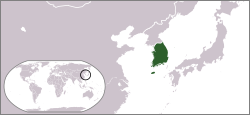Second Republic of South Korea
| Republic of Korea | ||||||||||
| 대한민국 大韓民國 |
||||||||||
|
||||||||||
|
||||||||||
|
Anthem 애국가 "Aegukga" |
||||||||||
|
South Korea in green
|
||||||||||
| Capital | Seoul | |||||||||
| Languages | Korean | |||||||||
| Government | Parliamentary republic | |||||||||
| President | Yun Po Sun | |||||||||
| Prime Minister | ||||||||||
| • | 1960 | Heo Jeong | ||||||||
| • | 1960–1961 | Chang Myon | ||||||||
| Legislature | National Assembly | |||||||||
| Historical era | Cold War | |||||||||
| • | Established | 19 April 1960 | ||||||||
| • | Coup d'état | 16 May 1961 | ||||||||
| Currency | Hwan (1953–1962) | |||||||||
|
||||||||||
The Second Republic of South Korea was the government of South Korea for eight months in 1960 and 1961. It succeeded the First Republic, and was followed by a military government under the Supreme Council for National Reconstruction. It was the only government under a parliamentary system in the history of Korea.
The First Republic was overthrown by widespread protests known as the "April Revolution" in April 1960. After its fall, power was briefly held by an interim administration under Heo Jeong. A new parliamentary election was held on 29 July 1960. The Democratic Party, which had been in the opposition during the First Republic, easily gained power and the Second Republic was established.
The Second Republic operated under a parliamentary system. This was the first and the only instance South Korea turned to a cabinet system instead of a presidential system. The legislature was bicameral, with the National Assembly as the lower house and the House of Councilors as the upper house. The president was elected by both houses of the legislature and served as head of state. Due to the numerous abuses of power by South Korea's first president, Syngman Rhee, the president's role was greatly reduced by the new constitution, to a point almost entirely ceremonial. Real power rested with the prime minister and cabinet, who were elected by the National Assembly. Yun Po Sun was elected as the President on 13 August 1960. The prime minister and head of government was Chang Myon.
The Second Republic saw the end of the severe curbs on political expression that had been in place under the Rhee regime. As a result, freedom returned, and with it came an increase in political activity. Much of this activity was from leftist and student groups, which had been instrumental in the overthrow of the First Republic. Union membership and activity grew rapidly during the later months of 1960. Around 2,000 demonstrations were held during the eight months of the Second Republic.
Under pressure from the left, the Chang government carried out a series of purges of military and police officials who had been involved in anti-democratic activities or corruption. A Special Law to this effect was passed on 31 October 1960. 40,000 people were placed under investigation; of these, more than 2,200 government officials and 4,000 police officers were purged. In addition, the government considered reducing the size of the army by 100,000, although this plan was shelved.
...
Wikipedia



